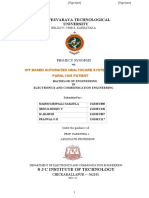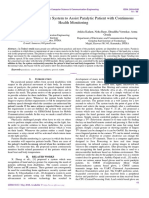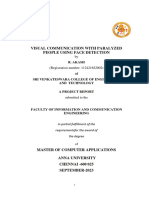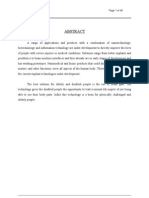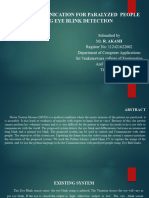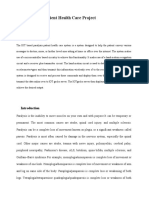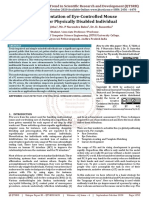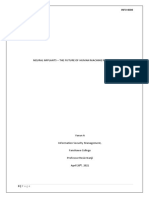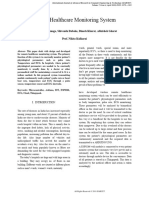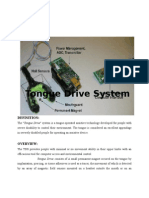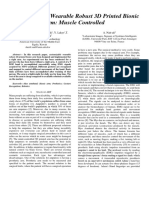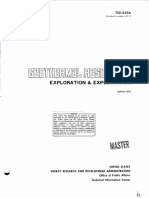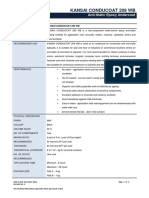International Research Journal of Engineering and Technology (IRJET) e-ISSN: 2395-0056
Volume: 08 Issue: 05 | May 2021 www.irjet.net p-ISSN: 2395-0072
AUTOMATED PARALYSIS PATIENT HEALTH CARE SYSTEM
Vidya Sarode1,K.R Alex Rappai2, Victor Thomas3, Akash Dubey4, Shashank Shukla5
1-5Student, Dept. of EXTC, XIE Mahim, Dept. of EXTC, XIE Mahim. , Dept. of EXTC, XIE Mahim.Dept. of EXTC,
XIE Mahim.
-----------------------------------------------------------------***-----------------------------------------------------------------
Abstract - The noble aim behind this project is to design a health care system which will be helpful for paralyzed
and mute people . A Dumb individual all through the world uses gesture based communication for the correspondence.
The progression in implanted framework can give a space to plan and build up an interpreter framework to change
over the communication via gestures into discourse. As sign language primarily used by deaf but also used by people
who can hear having problem in speaking so the approach used in this analysis is vision based. The glove uses are
fitted with flex sensor in three dimensions to collect the data from every position of figure and hand motion to
differentiate and distinguish each and every word from a particular sign. Heart attack is the major reason for death
among both genders men and women. However, its occurrence cannot be always predictable. Most common device used
to detect heart related problems is an EKG machine which is reliable to normal user, but is not mobile enough to be used
as a monitoring device for a heart patient continuously. This project is to develop an algorithm for detecting a heart
attack and if so, then to alert doctors, family members and emergency services .Hence here we introduce a smart
health care system which will take care of problems and need of paralyzed and mute people and will also help in
detection of heart attack.
Key Words: flex sensor, Mute People, Gesture Recognition, sign language.
1. INTRODUCTION
“AUTOMATED PARALYSIS PATIENT HEALTH CARE SYSTEM “is a recognition system for the vocally disabled. In real
world, there are many people who are paralytic and cannot communicate easily. Motions can be used to communicate
words and sentence to audience. The work of this project is to provide aid to such people with the help of motions
and sensors. A motion is used to provide a medium of sign for communication. The work includes use of various
electronic components such as sensors, microcontrollers which will help the disabled as well as the society.
For communication of paralytic people and electronic automated paralysis patient health care system is developed. It
is portable and very easy to handle. In this project angle sensor are used to convert physical parameter into electrical
signal, which can be read by an observer or by an instrument. So with help of this system the barrier faced by the
paralytic people in communicating with society can be reduced to great extent.
Various conditions such as stress, blood pressure and improper functioning of central nervous systems are reasons
which lead in paralytic attacks. Patient who had paralytic attack have their whole or partial bodies disabled. This
paralytic patient can neither speak nor express their demands or wishes. These patients cannot have quick reflex
system, hence there is no or less coordination between vocal systems, limbs and brain. In such situation, this
proposed project can come to the rescue. The patient can communicate by displaying the message on the LCD screen
by simple motion of their functioning body parts. The particular aspect of this device is that if no one is near by the
patient, he can send the message in the form of a SMS to the family members or their caretaker through the
developed mechanism.
2. LITERATURE SURVEY
According to a survey, nearly 1 in every 5000 people are paralyzed. Fully paralyzed patients require 24 hour support.
But in this days, it is not possible to constant monitor patient. So they need a person which take care’s movement
disabled or paralyzed patient. And appliances cannot be handled by them. So they need constant help and they cannot
work independently there are various applications which can be drive from eye blink detection and these are not
limited. Anefficient, real time blink detection can be used for almost any purpose. It can be used for on/off appliances
such as lighting devices, fan, television or a microwave oven. Electrooculographic direction of a wheelchair utilizing eye
development A convenient remote eye development controlled Human Computer Interface (HCI) for debilitated
individual Eye controlled turning on and off the electronic gadgets Launching the rocket utilizing look in war field A
few inquires about have been done as of late to develop Human Computer Interface [HCI][4].Human Computer
Interface as an assistive innovation helps the general population with engine incapacities and who can't move their
arms thus mind boggling human PC interface must be more developed, specific to that of the information charges,
adjusted - to the incapacity of the user, designed in a sheltered and straightforward way. Under to human PC interface
© 2021, IRJET | Impact Factor value: 7.529 | ISO 9001:2008 Certified Journal | Page 680
� International Research Journal of Engineering and Technology (IRJET) e-ISSN: 2395-0056
Volume: 08 Issue: 05 | May 2021 www.irjet.net p-ISSN: 2395-0072
the most developed. The primary point of the proposed framework is to build up a financially savvy framework which
can offer voicetovoicelessindividualwiththeassistanceof Smart Gloves. Itimpliesthatutilizing
brilliantglovescorrespondencewon'tbe obstruction between two distinct groups and they will have the capacity to
discuss effortlessly with the typical individual. Utilization of keen glove by individual with incapacity influences
country to develop and furthermore they won't vary themselves from the typical individuals. In this paper Quiapo
et.al. Cover the various prevailing methods of deaf-mute communication interpreter system. The two broad
classification of the communication methodologies used by the deaf –mute people are - Wearable Communication
Device and Online Learning System. Under Wearable communication method, there are Glove based system, Keypad
method and Handicom Touch-screen. All the above mentioned three sub-divided methods make use of various
sensors, accelerometer, a suitable micro-controller, a text to speech conversion module, a keypad and a touch-screen.
The need for an external device to interpret the message between a deaf –mute and non-deaf-mute people can be
overcome by the second method i.e online learning system. The Online Learning System has different methods. The
five subdivided methods are- SLIM module, TESSA, Wi-See Technology, SWI_PELE System and Web-Sign Technology
[1].
In another research Abhinandan Das et.al proposed ISLR system is considered as a pattern recognition
technique that has two important modules: feature extraction and classification. The joint use of Discrete Wavelet
Transform (DWT) based feature extraction and nearestneighbour classifier is used to recognize the sign language. The
experimental results show that the proposed hand gesture recognition system achieves maximum 99.23%
classification accuracy while using cosine distance classifier [2] . In their research Anetha K et.al. presented a scheme
using a database driven hand gesture recognition based upon skin color model approach and thresholding approach
along with aneffective template matching with can be effectively usedfor human robotics applications and similar other
applications.. Initially, hand region is segmented by applying skin color model in YCbCr color space. In the next stage
thresholding is applied to separate foreground and background. Finally, template based matching technique is
developed using Principal Component Analysis (PCA) for recognition [3]. Aarthi M et.al. Presented the static hand
gesture recognition system using digital image processing. For hand gesture feature vector SIFT algorithm is used.
The SIFT features have been computed at the edges which are invariant to scaling, rotation, addition of noise [4].
Priyanka Lokhande et.al proposed a method for automatic recognition of signs on the basis of shape based features
is presented. For segmentation of hand region from the images, Otsu’s thresholding algorithm is used, that chooses
an optimal threshold to minimize the within-class variance of threshold black and white pixels. Features of segmented
hand region are calculated using Hu’s invariant moments that are fed to Artificial Neural Network forclassification.
Performance ofthe systemis evaluated on the basis of Accuracy, Sensitivity and Specificity [5 ].
Another Authors Anetha K et.al presented various method of hand gesture and sign language recognition
proposed in the past by various researchers. For deaf and dumb people, Sign language is the only way of
communication. With the help of sign language, these physical impaired people express their emotions and thoughts
to other person [6]. Priyanka R Potdar et.al. Proposed a system to aid communication of deaf and dumb
peoplecommunicationusing Indiansignlanguage (ISL) with normal people where hand gestures will be converted into
appropriate textmessage. Main objective is to designan algorithm to convert dynamic gesture to text at real time.
Finally after testing is done the system will be implemented on android platform and will be available as an application
for smart phone and tablet pc [7]. Another Author proposed a real time vision based system for hand gesture
recognition for human computer interaction in many applications. The system can recognize 35 different hand gestures
given by Indian and American Sign Language or ISL and ASL at faster rate with virtuous accuracy. RGB-to-GRAY
segmentation technique was used to minimize the chances of false detection. Authors proposed a method of
improvised Scale Invariant Feature Transform (SIFT) and same was used to extract features. The system is model
using MATLAB. To design and efficient user friendly hand gesture recognition system, a GUI model has been
implemented [8].
One of the researcher Sachin Bhatt et.al. Presented the recent research and development of sign language
based on manual communication and body language. Sign language recognition system typically elaborate three
steps preprocessing, feature extraction and classification .Classification methods used for recognition are Neural
Network (NN), Support Vector Machine(SVM), Hidden Markov Models (HMM) [9]. Mukul Singh Kushwah et.al.
Presented application that helps the deaf and dumb person to communicate with the rest of the world using sign
language. The key feature in this system is the real time gesture to text conversion. The processing steps include:
gesture extraction, gesture matching and conversion to speech. Gesture extraction involves use of various image
processing techniques such as histogram matching, bounding box computation, skin colour segmentation and region
growing. Techniques applicable for Gesture matching include feature point matching and correlation based
matching. The other features in the application include voicing out of textand text togestureconversion[10].
© 2021, IRJET | Impact Factor value: 7.529 | ISO 9001:2008 Certified Journal | Page 681
� International Research Journal of Engineering and Technology (IRJET) e-ISSN: 2395-0056
Volume: 08 Issue: 05 | May 2021 www.irjet.net p-ISSN: 2395-0072
3. PROPOSED SYSTEM
Sign languages are languages that use the visual-manual modality to convey meaning. Language is expressed via the
manual sign stream in combination with non-manual elements. Sign languages are full-fledged natural languages
with their own grammar and lexicon. This means that sign languages are not universal and they are not mutually
intelligible, although there are also striking similarities among sign languages.
Fig -1: Block diagram of Assisting System for Paralyzed and Mute People with Heart Rate Monitoring
Linguists consider both spoken and signed communication to be types of natural language, meaning that both emerged
through an abstract, protracted aging process and evolved over time without meticulous planning. Sign language
should not be confused with body language, a type of nonverbal communication. Wherever communities of deaf
people exist, sign languages have developed as handy means of communication and they form the core of local deaf
cultures. Although signing is used primarily by the deaf and hard of hearing, it is also used by hearing individuals,
such as those unable to physically speak, those who have trouble with spoken language due to a disability or
condition (augmentative and alternative communication), or those with deaf family members, such as children of
deaf adult.
In this system we used handicap wheelchair which basically works on the principle of acceleration, one
acceleration sensor, provides two axes, acceleration sensors whose output is analog, varies according to
acceleration applied to it, by applying simple formula we calculate the amount of tilt and output of tilt will decide to
move in which direction. Sensorgives X-axis and Y-axis output independently which is fed to ADC and then micro
controller and depending on the pulse width it decides to move or not. As from the circuit diagram it is clear that
we have used micro controller AVR. So the accelerometer sensor is connected to the port 3 of micro controller.
Depending on the movement of sensors, the motor moves in any of the four directions (i.e. left, right, forward,
backward). If the four fingers of the left hand are bend the wheel chair will move in forward direction. And if the
middle two fingers of the left hand are bend then the wheel chair moves in reverse direction. If the two fingers from the
right hand side are bend then wheel chair moves in right direction. In the same way if the two fingers from the left hand
side are bend then the wheelchair moves in the left direction. Similarly, the movement of single fingers are bend one
by one then various commands are recorded on that particular movements for helping the patient.
© 2021, IRJET | Impact Factor value: 7.529 | ISO 9001:2008 Certified Journal | Page 682
� International Research Journal of Engineering and Technology (IRJET) e-ISSN: 2395-0056
Volume: 08 Issue: 05 | May 2021 www.irjet.net p-ISSN: 2395-0072
4. SYSTEM IMPLEMENTATION
RECEIVER:
Fig -2: Circuit diagram of Assisting System for Paralyzed and Mute People .
The antenna starts the job of reception it gives the signal to receiver module. The receiver module receives it and de
module the signal, it can be any amplifier (required one only).4MHz Oscillator is used to give clock to the
microcontroller as a carrier.5V regulated supply is used for voltage supply. Then the signal fed to microcontroller if
the motion of hand is continuously on the microcontroller will send a SMS to the number shared in it and it will show the
output on LCD display. If motion looks normal or not incontinuous type it will just show to on LCD display. LCD display is
used to show the output which is given by microcontroller. The GSM modem used to send a SMS on the number which is
saved in it. It need a SIM cared for transmission of message.
© 2021, IRJET | Impact Factor value: 7.529 | ISO 9001:2008 Certified Journal | Page 683
� International Research Journal of Engineering and Technology (IRJET) e-ISSN: 2395-0056
Volume: 08 Issue: 05 | May 2021 www.irjet.net p-ISSN: 2395-0072
TRANSMITTER:
The transmitter is the attached to the patient it contains the acceleration sensor, analog /digital converter, PIC
microcontroller and transmitter module the 5V power supply is attached to it for the input. As the acceleration
sensor is work on the motion, it converts hand (Mechanical) energy to electrical (analog)energy it gives to ADC.ADC
is used to convert analog signal (continuous signal) into digital signal (bit sequence) as output is given to
microcontroller. The 5V voltage regulator is attached with microcontroller for giving voltage to it. As
microcontroller gets the information is send a message to the number to receiver end via transmitter module.
Through transmitter module the signal is radiated on receiver via a antenna. Signal generated by transmitter is goes
to the receiver end. ADC is used to give the desire output which PIC microcontroller needed and makes the circuit
easy. Antenna gives extra gain (dB) for better transmission through air.
Fig 3. -: Automated Paralysis Health Care System.
© 2021, IRJET | Impact Factor value: 7.529 | ISO 9001:2008 Certified Journal | Page 684
� International Research Journal of Engineering and Technology (IRJET) e-ISSN: 2395-0056
Volume: 08 Issue: 05 | May 2021 www.irjet.net p-ISSN: 2395-0072
4. EXPERIMENTAL RESULTS
Transmitter
Section
Power Supply Testing Microcontroller Testing
1)Input Voltage Testing- 11.96v dc (12v dc), 1)Pin no 19 is ground.
2)After Connecting Power Supply LED should be ON. 2)Pin no 20 is VCC- 4.98v.
3)Voltage Regulator IC Input Voltage- 11.27v. 3)Pin no 6 is ground.
4)Pin 1 is input. 4)Pin no 20 is VCC- 4.98v.
5)Pin 2 is Ground. 5)Pin no 1 reset input voltage- 5.4v.
6)Voltage Regulator IC Output Voltage -4.98v(5v regulator)
7)Pin No 3 is output pin.
Receiver
Section
Power Supply Testing Microcontroller Testing LCD Testing
1)Input Voltage Testing- 11.96v dc Pin no. 1 Reset input voltage: - Pin no.1 is ground
4.75v
2)After Connecting Power LED should Pin no. 11 is VCC: - 5V Pin no.2 is VCC: -5v
be ON.
3)Voltage Regulator Input 10.51v. Pin no.12 is ground Pin no. 15 is VCC: - (Note- LCD backlight
supply (5v)
4)pin 1 is input Pin no.31 ground Pin no. 16 is ground
5)pin 2 is ground Pin no. 32 VCC: -5v Pin no.3 is contras voltage input: - 0 to
5v variable
6)Voltage Regulator IC output -5v
5. CONCLUSION
Processing speeds of computers have increased dramatically, with computers being advanced to the levels
where they can assist humans in complex tasks.
It is justified that sign language decoding using these modern techniques helps in achieving more efficiency
in the field of gesture recognition thus making it easy to understand for everyone.
© 2021, IRJET | Impact Factor value: 7.529 | ISO 9001:2008 Certified Journal | Page 685
� International Research Journal of Engineering and Technology (IRJET) e-ISSN: 2395-0056
Volume: 08 Issue: 05 | May 2021 www.irjet.net p-ISSN: 2395-0072
To continue this moment, it is clear that further research in the areas of future extraction, classification
methods, and gesture representation are required to realize the ultimate goal of humans interfacing with
machines on their own natural terms.
This project is useful for deaf and dump people those cannot communicate with normal person. It is also
useful for speech impaired and paralysed patient means those do not speak properly.
6. REFERENCES
[1] Fels and G Hinton “Glove-talk: A neural Network Interface between a Data-Glove and a Speech Synthesizer”, IEEE
Transactions on Neural Networks, 4-1, pp. 2-8.1993.
[2] Corradini, Andrea, Horst-Michael Gross. 2000, "A Hybrid Stochastic- Connectionist Architecture for Gesture
Recognition’’, 2000 IEEE, 336-341.2000
[3] K. Solanki, ‘’Indian Sign Languages Using Flex Sensor Gloves’’, IJETT, Volume-4, Issue-6, June 2013.
[4] S. Ahmed. C. Abdul Melvisharam, ‘’Hand Gesture Recognition and Voice conversion system for Differentially Able
Dumb People’’, Hakeem college of Engineering and Technology Vellore, Tamil Nadu 632 509. 2012
[5] J. Ravikiran, K. Mahesh, S. Mahishi, R. Dheeraj R, "Finger Detection for Sign Language Recognition" International
Journal of Development Research. Vol. 4, Issue-3, pp. 749- 752, March 2014.
[6] J. Haydar, B. Dalal, S. Hussainy, L. Khansa, Walid Fahs submitted report on “ASL Finger Spelling Translator Glove”,
Faculty of Engineering, Islamic University of Lebanon Khandesh, Lebanon,2000
[7] T. Dasgupta, S. Shukla, S. Kumar, S. Diwakar, A. Basu submitted report on “A Multilingual Multimedia Indian Sign
Language Dictionary Tool”, department of Electronics & Communication engineering, andra-pradesh,2012
[8] S. Bandopadhyay, “Sign language glove with voice synthesizer” Department of Electronics & Communication
Engineering, RCC-Institute of Information Technology, West Beng University of Technology, June-2012.
[9] S. Mitra and T. Acharya, “Gesture Recognition: A Survey”, IEEE transactions on systems, man, and cybernetics—
part c: applications and reviews, vol. 37, no. 3, page no. 311-317, MAY 2007
[10] I. Vladimir R. Sharma and T. Huang, “Visual Interpretation of Hand Gestures for Human-Computer Interaction: A
Review”, IEEE transactions on pattern analysis and machine intelligence, vol. 19, no. 7page no. 677-68., JULY 1997.
[11] M. Sweta, A. Raut and N. Janwe, “A Review of Gesture Recognition Using Image Object Comparison and Neural
Network”, International Journal of Computer Technology and Electronics Engineering (IJCTEE) National Conference
on Emerging Trends in Computer Science and Information Technology (NCETSIT-2011), Page No.57-58.
[12] M. Mokhtar, P. Mishra, “Hand Gesture Modeling and Recognition using Geometric Features: A Review”, Canadian
Journal on Image Processing and Computer Vision Vol. 3 No. 1, Page No. 13-16., March 2012
[13] H. Gunes and M. Piccardi, “Automatic Temporal Segment Detection and Affect Recognition from Face and Body
Display”, IEEE transactions on systems, man, and cybernetics—part b: cybernetics, vol. 39, no. 1, Page No. 70-72.
FEBRUARY 2009
[14] Gloves Translate Sign Language to Speech "http://www.escapistmagazine.com/" 2012
[15]http://dspace.bracu.ac.bd/xmlui/bitstream/handle/10361/10106/12321021%2C12301040%2C14121084%2C123010
48_CSE.pdf?sequence=1&isAllowed=y
[16]https://www.researchgate.net/publication/329268152_Heart_Attack_Detection_and_Heart_Rate_Monitoring_Using_IoT
[17]https://krex.kstate.edu/dspace/bitstream/handle/2097/38268/NarasimhaRaoJastiMadhu2017.pdf?sequence=3
[18]http://www.ijfrcsce.org/download/browse/Volume_4/May_18_Volume_4_Issue_5/1526794433_20-05-2018.pdf
© 2021, IRJET | Impact Factor value: 7.529 | ISO 9001:2008 Certified Journal | Page 686


